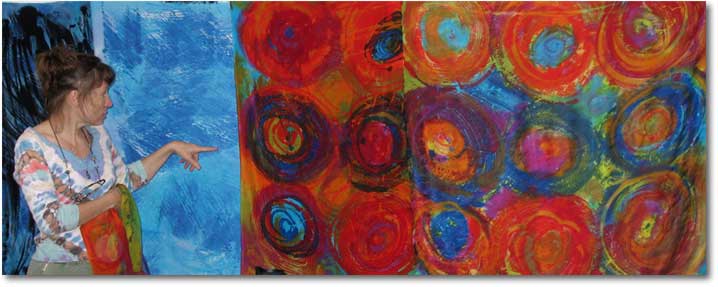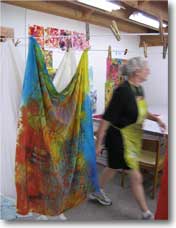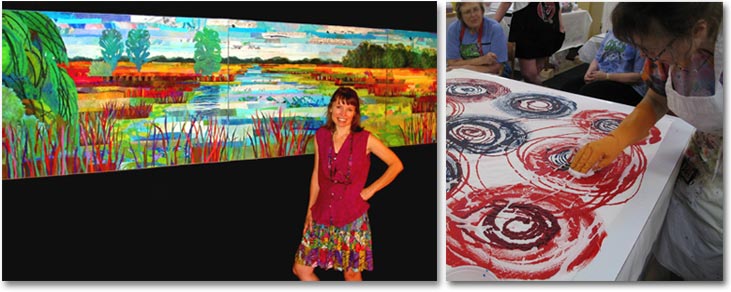SUE BENNER
Sue Benner was born in Iron River, Michigan, and was raised in Oshkosh, Wisconsin. While attending the University of Wisconsin - Madison and majoring in molecular biology, she took two electives, fabric design and art history, that would point her in a different direction. Many more art and science classes followed that led to a masters in Biomedical Illustration. Since then she has worked as a self-employed studio artist for more than twenty years, creating works of dyed and painted textiles. Her work is shown internationally and is in many corporate, private, and institutional collections. She has designed installations for architectural spaces in fabric and other media. Her work has appeared in numerous juried shows, such as QUILT NATIONAL, VISIONS, and QUILT NIHON. Sue paints, draws, and sews in her custom-built studio behind her home in Dallas, Texas, where she lives with her husband and two sons.
Sue's web site: www.suebenner.com
Sue Benner with her work, teaching at the Crow Timber Frame Barn and one of her students.
BROAD BRUSH: DYE-PAINTING & PRINTING with PROCION DYES
• Dates: October 19-23, 2009
• Level: Intermediate to Advanced
• Zig Zag Sewing Machine: No
• Tuition & Meal Plan: $770
• Materials Fee: $90
• Dye Facility Usage Fee: $25
> Accommodations and meal information

DESCRIPTION
Bold and expressive use of Procion MX and H dyes is the goal of this workshop. Sue teaches her layered painterly approach using direct application, mono-printing, and various other techniques. Emphasis is also placed on developing sophisticated color combinations, using interesting tools, along with adding touches of metallic and opaque fabric paints. Sue will share helpful hints, technical information, and her own variations.
Make your marks, brush your strokes, and record it all on fabric!
(This class will cover similar basic material as Sue's previous dye painting classes with updates and her continued experimentation.)
SUPPLY LIST
• 3-6 paint brushes, 1/4”-3” wide (Sue uses brushes for acrylic paint and inexpensive natural bristle house painting brushes.)
• 2-4 plastic spray bottles (recycled ones from home products), 2-4 squeeze tubes (used for hair dye and similar products), about 20 (16-20 oz.) plastic cups (the frosty, translucent ones work well because you can see the color), recycled yogurt or cottage cheese cups with lids if you have some.
• Plastic drop cloths for placing under and covering fabric. Several packets or a roll will do. Thicker plastic is easier to wash and reuse, thinner plastic is cheaper but harder to reuse.
• 5-10 one-gallon plastic bags with easy closure and good seal.
• 10-25 yards of white cotton, silk, or rayon, prepared for printing (PFP) or dyeing (PFD), or scoured yourself to remove fabric treatments (directions available). You can buy such fabrics from Testfabrics (570-603-0432), PRO Chemical and Dye (www.prochemical.com), Dharma Trading Co. (www.dharmatrading.com), or Exotic Silks (800-845-7455). Thai Silks is the retail version of Exotic Silks (www.thaisilks.com). Good quality fabric will give the best results. Cotton that is mercerized is treated to accept dyes more readily and will dye more brightly (this is very important for bright and deep color!). Fabrics can be cut into 1 yard lengths and labeled with your name.
• Clothing to wear while painting (stains will be permanent), rubber gloves, such as Playtex, or waterproof gloves of your choice.
• Dust masks (required) or respirator (only if you already have one).
• Stamps, tools, clamps, blocks, clothespins, etc. that you may have in your studio already.
• Five slides of your work, a portfolio if you have one, a small work if possible.
• Camera and film or digital camera, optional.
• Notebook or sketchbook for recording formulas and colors.
• Scissors.
• Roll of paper towels.
• Roll of masking tape.
• Sharpie, fine point.
Please note: if you have a dye color-mixing reference (like some of the sample/formula notebooks produced in workshops) for Procion dyes, I strongly suggest bringing it for this class.
If you want to prepare some fabric in advance for MX dye-painting, here is the soda-soak method:
Remember to use fabrics suggested in supply list. You could prepare 10-25 yards.
• Scour (pre-wash)
Wash and dry fabric to remove sizing and other contaminants; this is called “scouring,” and is ideally done with a half teaspoon each of Synthrapol and soda ash per pound of fabric in hot water (140 degrees) for 15 minutes. If your machine load is completely full, 2 teaspoons of each should do it. Note: Cottons vs. silks! Sue machine washes cottons on regular cycle, very hot water, machine dry. She machine washes silks on gentle, warm water, and drip dry.
If fabrics are listed as PFP or PFD (Prepared For Printing or Dyeing) you do not have to scour. However, you still need to soda soak!
Cut fabrics in 1 yard lengths and label (in a corner) with your initials using Sharpie.
• Soda soak
Dissolve 9 T. soda ash (also called Pro Dye Activator by ProChemical and Dye, see website below) in one gallon of warm water.
Immerse DRY fabric in solution, about 15 minutes, wring out (can use washing machine if no extra water is added in spin), and hang to dry. You can save the left-over soda solution for later use – just be sure to cover it. If you ever have any question about the strength of your soda soak solution, start over with a new batch. Better to be safe than sorry.
If you want to remove wrinkles, iron on low temperature only to prevent scorching, no steam, store in plastic bag and bring to class. Remember to wash ironing board cover afterward to remove soda (or cover with another cloth in the first place).
If you can’t do this at home or studio, don’t worry, you can do it at the CROW BARN when you get there.
You can also look this up on Pro Chemical and Dye’s website, www.prochemical.com, or look in Ann Johnston’s wonderful book, Color By Design: Paint and Print with Dye, page 28.
SUPPLIES SUE WILL HAVE ON HAND:
• Camera
• Dyes, paints, chemicals, etc.
• Plastic spoons
• Extra plastic drop cloths
• Tools
• Cotton and silk (if you are interested in buying some from Sue please email or call her in advance.)
MATERIALS FEE PROVIDES:
• All dyes, chemicals, paints, etc. The cost may vary somewhat depending on price increases, discounts due to volume, and shipping charges. Sue will calculate this amount again closer to the class date.
> Close this window to return to the main site or click on a link below | Questions? > Email
Nancy Crow | Home | Tours | Barn Workshops | New Book | Gallery | Bio | Email
© 2002-2009 Nancy Crow, llc | Site designed by Nathaniel Stitzlein | Art Grange Studios
Notice: All images & materials on this site are protected by copyright law and may not be reproduced in whole or in part without the express written permission of Nancy Crow or the artist.
> Click here to see an image gallery of the Crow Timber Frame Barn

